CricViz Analysis: How to beat Chennai Super Kings
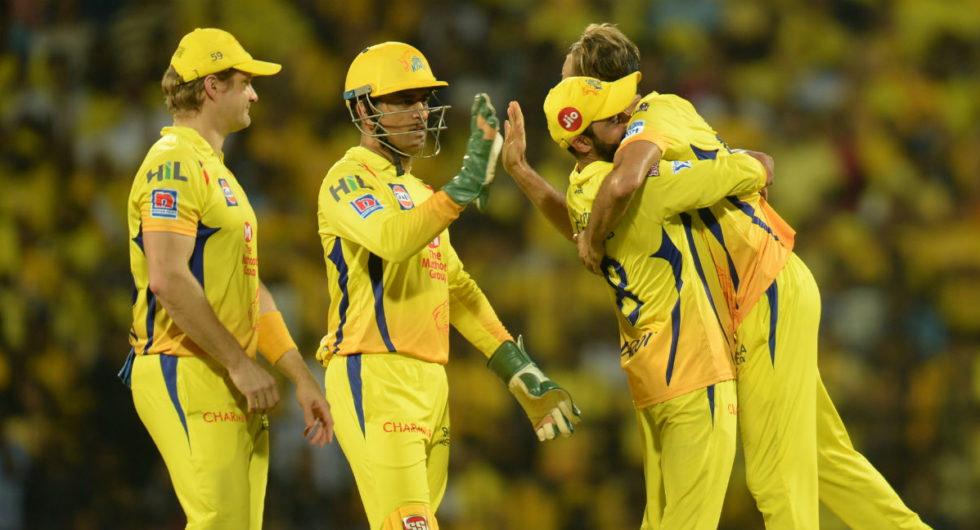
Photo credit: AFP
Ben Jones and Freddie Wilde consider how teams can land a blow on MS Dhoni’s side.
With six wins from seven matches the Chennai Super Kings are very well set to finish in the top four and qualify for the Play Offs yet again – maintaining their astonishing record of qualifying every season they have played. Since the start of the last IPL – which CSK won – they have clearly been the strongest team in the IPL winning 17 of their 23 matches, returning the best win percentage in the league of 74% – well clear of the next best.
According to CricViz Match Impact Chennai’s squad is not one of the strongest in the IPL, yet they consistently exceed expectations by relying on a core set of players with clearly defined roles. They know their strengths and play to them very effectively.
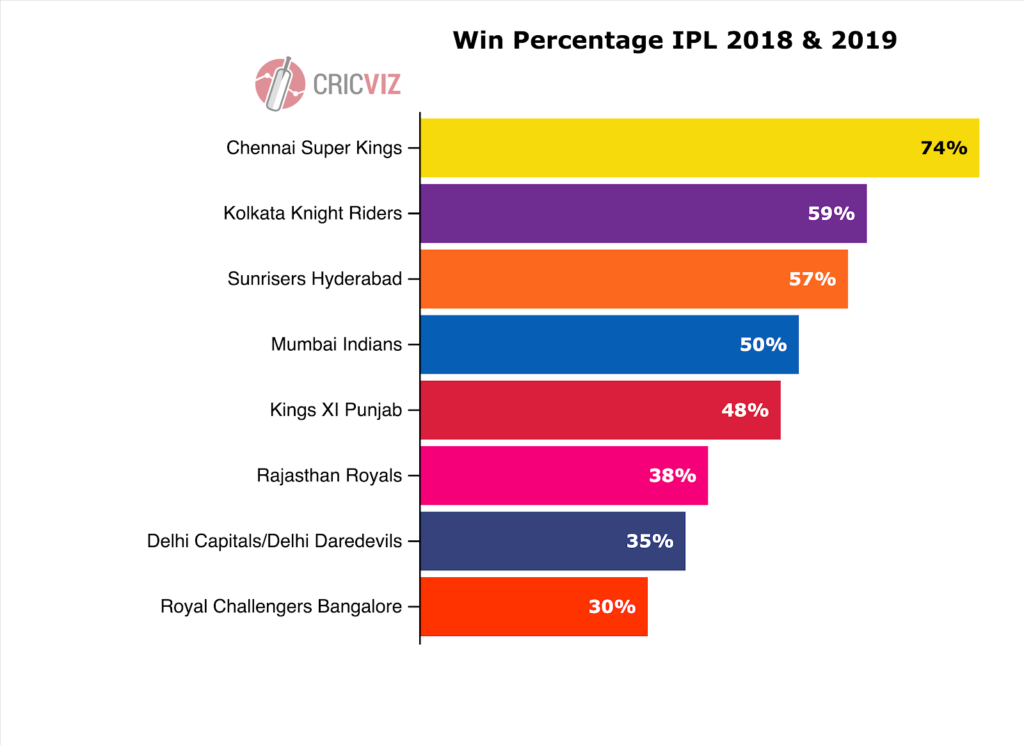
However, while Chennai are clearly a superb team they are not without flaws. Using CricViz data, analysts Ben Jones and Freddie Wilde consider how teams can stop the CSK juggernaut as we enter the second half of the 2019 season.
1 – Use Home Conditions
The ‘S’ in CSK refers to ‘Super’, but it could very easily refer to ‘spin’; Dhoni’s men really are the Chennai Spin Kings. Their squad is packed with high-quality, often experienced, gun-T20 spinners. Harbhajan Singh (projected bowling impact +1.03), Imran Tahir (+2.55), Ravi Jadeja (-0.70), Mitchell Santner (+1.16) and Karn Sharma (+0.31) – they are all canny, accurate white ball bowlers, who are as capable of strangling opposition innings as they of blasting them away.
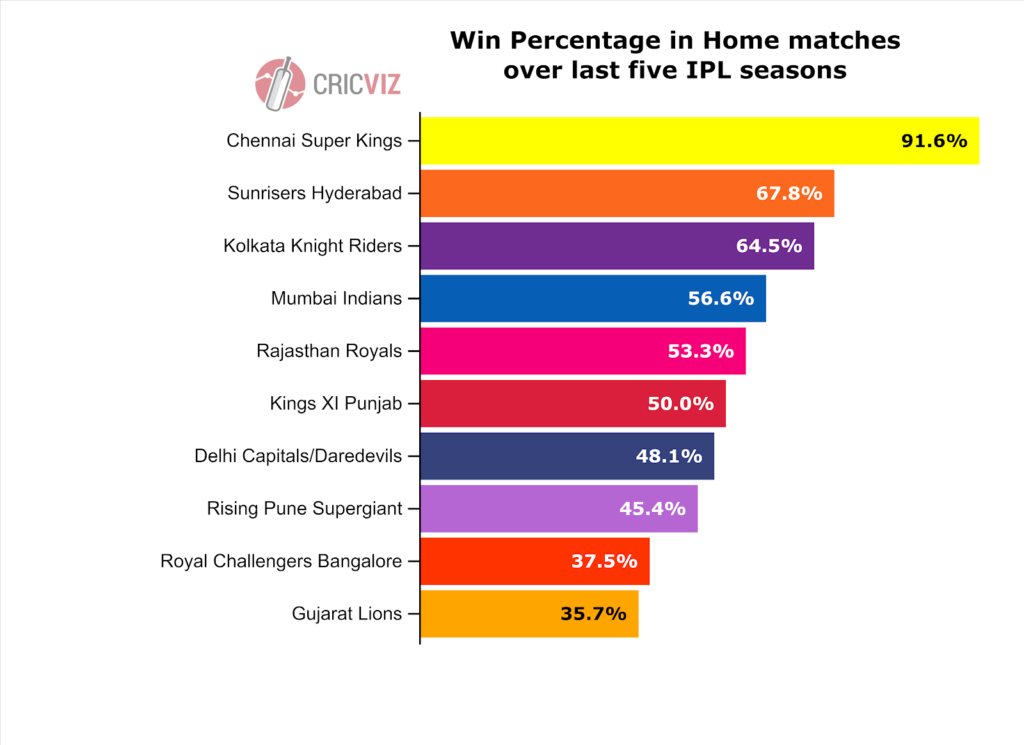
As such, Chepauk (Chennai’s home ground) is generally a spin-friendly surface, at times to an almost comical extent, as we saw when CSK routed RCB for just 70 the opening match of this season. As such, they are dominant at home – in the last five seasons of IPL, they have the highest win percentage at home of any side.
It follows therefore that as an opposing side you should look to disrupt them when they come to play at your venue. Preparing a seamer friendly surface will undoubtedly negate their strong spin attack, and force Dhoni to turn to his seamers – whilst this may have been a viable back up whilst Lungi Ngidi and (to a lesser extent) David Willey were around the squad, their back-ups are not quite of the same quality, and will struggle to replicate the effectiveness of Harbhajan et al.
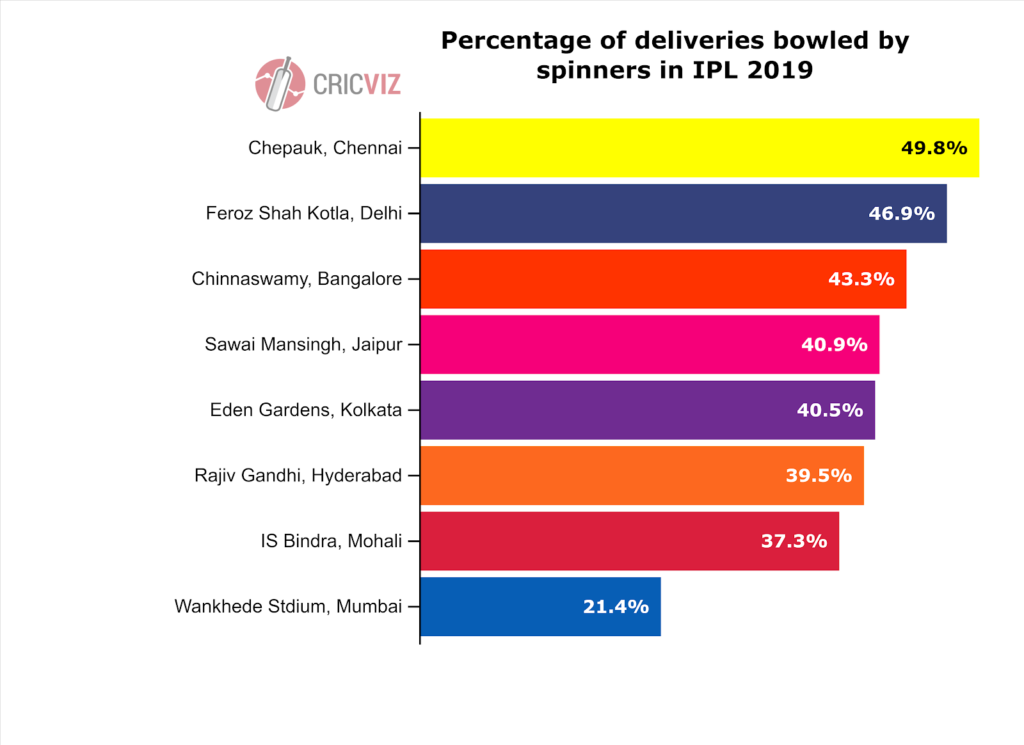
2 – Luck
One of cricket’s enduring charms is the role that a coin toss can play in influencing results, even amidst the glitz and glamour of the IPL. Chasing has become an ever more accepted default for T20 captains, a result of the increased win percentages for sides batting second. You win the toss, and generally you chase.
As for many others, this has been the case for CSK. In the past two IPL seasons, they have an 80% win percentage when chasing, but that falls to 63% when they bat first. It’s not disastrous – they are still a fine team, regardless of the order in which they deploy their skills – but it is clearly their weaker suit. If you can force them onto the back foot in this regard, and keep them from chasing, then you’re already working from a strong position.
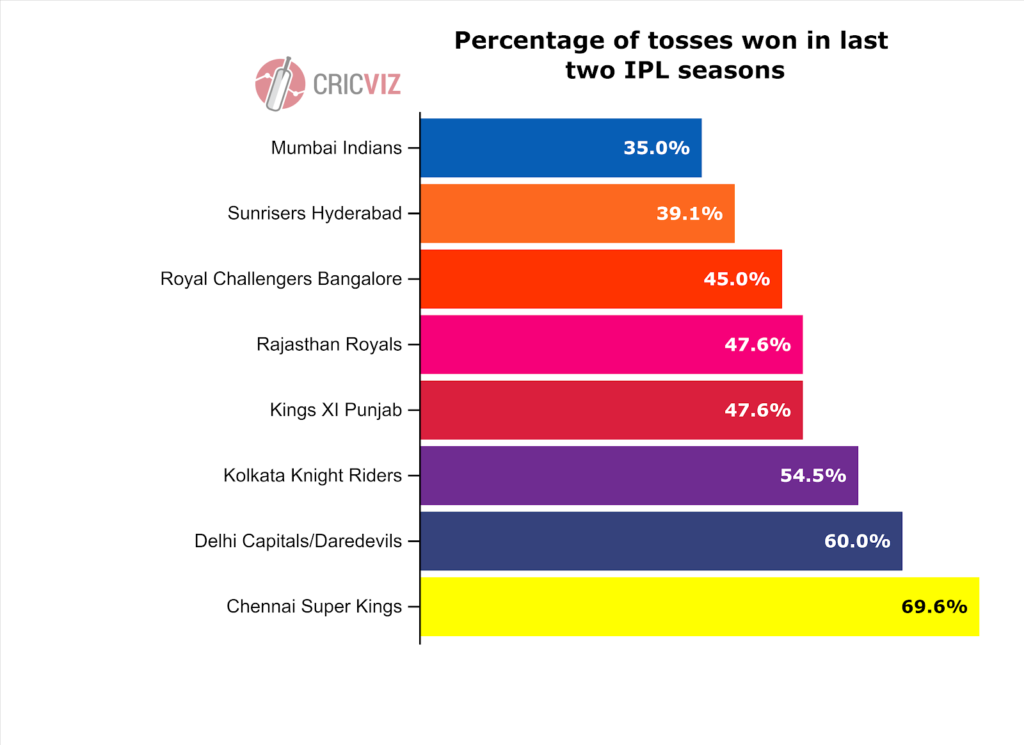
Which is where luck comes in. Since their readmission to the IPL following a ban for spot-fixing, CSK have enjoyed a streak of luck. They have won 70% of their tosses, more than any other team in the competition, a streak which has given them a slight head-start in most of their matches. Of course, as an opposing captain you have no control of this aspect of proceedings. At times against CSK, it can feel like you have no control of any aspect. But in this area, you simply have to cross your fingers, pray, and hope that things go your way.
3 – Focus Batting Selection on Spin
Chennai are a superb spin attack – makes sense that you’re batting line-up is put together with this in mind. With DJ Bravo struggling with fitness, the quality of CSK’s seam attack minimal compared to the spinners. As such, you should look to select good players of spin, and back them to adapt against Chahar, Scott Kuggeleijn and co.
In particular, an intelligent way to construct the batting line-up is to have an even mix of left-handed and right-handed batsmen. Whilst all three of the spinners that Chennai have used frequently this season have performed excellently, they each prefer bowling to either RHB or LHB, as shown in the table below.

What’s more, the pattern holds up across these players’ careers. Harbhajan is more economical against left-handed batsmen, whilst Tahir and Jadeja are more economical against right-handers.

Chennai take this pattern into consideration, particularly with regard to Harbhajan; he played against RCB who had four left-handers in their top six, but didn’t play against RR who had just one leftie in their top six. It follows that if your top-order is a blend of both, you’re giving yourself the best chance of forcing Dhoni to turn to bowlers unsuited for at least one of the batsmen. Individual performances can win you matches occasionally, but making sure that you put the right individuals in the right situations is paramount.
4 – Attack Chahar
Deepak Chahar is hardly the most heralded member of the Chennai Super Kings squad, but he plays an extremely crucial role. A Powerplay specialist (83% of his IPL career deliveries have been in the Powerplay), he gets stuck into the bulk of his work at the start of the innings. That’s been the case this season as well, taking the new ball and with exceptional skill; a strike rate of 16.2 twinned with an economy of 6.29 RPO paint a picture of a very canny operator.
However, this reliability is double-edged – it makes CSK predictable. Teams know that, realistically, Chahar is going to lead the attack, and if they can go after him it disrupts all of the other plans CSK have in store. This isn’t to denigrate Chahar’s role, or his effectiveness in it, but rather to acknowledge that his skills are specific to the Powerplay, and that he is a less versatile bowler than the other stars in the CSK squad. Chahar has never taken an IPL wicket in the middle overs and he has bowled just three overs at the death.

In the one match CSK lost this season the Mumbai Indians attacked Chahar’s third over – taking him for 14 runs and forcing Dhoni to remove him from the attack after three overs – the first time in the season that he didn’t bowl his four overs consecutively.
The option to deploy a pinch-hitter from lower down the order, one who preferably specialises in scoring briskly against pace bowling, is a good one. This allows you the benefits of perhaps hitting Chahar out of the attack – benefits that are numerous, and of consequence throughout the innings – but without the risk of losing a top-order batsman on a kamikaze mission.
Batsmen can be confident that they know where Chahar is going to bowl – because he rarely changes his plan. He largely bowls good lengths in the corridor outside off stump. Batsmen could disrupt his line and lengths by using their feet to come down the track or to back away and give room to hit over the top of the inner ring.

5 – Attack in Powerplay and at the Death
Attacking Chahar in the Powerplay is the basis of a more general strategy that teams should adopt against CSK of attacking hard at the top and tail of the innings. CSK’s strongest bowling phase is the middle overs where they deploy their spinners and teams who have beaten CSK in the past two seasons have had success by attacking hard in the Powerplay and at the death and stabilising against the strong spinners through the middle overs.
This is illustrated by True Run Rate which compares the run rate of a team in an over with the average run rate for that specific over in that year. For example a team who scored 9 runs off the first over of an innings in 2018 would have a True Run Rate of +2.60 because the average run rate in the first over last year was 6.40.
The table below shows that teams who have beaten CSK in the past two seasons have generally done so by capitalising in the Powerplay and particularly at the death where they have scored +2.63 runs per over above expectation.

The death overs is certainly CSK’s weakest phase. In the period they have generally relied on Dwayne Bravo and Shardul Thakur who have bowled 58% of their deliveries in the phase. Both Bravo and Thakur are vulnerable at the death – as illustrated by their True Economy Rate since the start of last season.

Of course, attacking at the top of the innings risks losing early wickets which in turn makes the middle overs stabilising period more difficult which then makes launching at the death difficult. It’s a high-risk strategy but that’s kind of the point. Chennai are a very well structured bowling team and disrupting them is difficult. Teams who bat aggressively in the Powerplay risk being well beaten but at least they are giving themselves a chance.
6 – Don’t let Dhoni take it deep
This season CSK’s top order has been flattened twice by Rajasthan Royals who reduced Chennai to 27 for 3 in Chepauk and 24 for 4 in Jaipur but on both occasions brilliant fifties from Dhoni rescued the innings. In Chepauk they ended up posting 175 – which proved too many for the Royals and in Jaipur they tracked down their target of 152 off the last ball.
Dhoni’s ability to soak up pressure through the middle overs and take CSK to within striking distance of a target is one of his hallmarks. Although it is tempting to settle for what seems like a middle overs stalemate when Dhoni is rebuilding the innings, history has shown this to be a dangerous strategy. Dhoni’s hitting prowess may well have declined over the years but his tactic of taking the game deep takes CSK close enough for other lower order hitters to take them home.
Teams should therefore look to attack Dhoni early, or at the very least squeeze him with tight fields and force him to hit over the ring and take a risk, rather than giving him easy singles. Among the attacking options to target Dhoni full slower balls is one good option.

If you’re a spinner, the slower ball isn’t available to you as a variation, so you have to find another edge. If you are a leg-spinner, then the googly is a solid option, given that they dismiss Dhoni significantly more often than a standard leg break. It’s not a silver-bullet, but it’s an opportunity to disrupt his rhythm.

Conclusion
Indeed, that last point is true for all of these ideas. None of them will, on their own, guarantee that your team will beat CSK. If you managed to execute all of these strategies at once, you’d be a remarkably flexible and effective team; however, in this piece are a series of strategies that if implemented well, give you a better chance of coming out on top, than if you went into the match with no plan at all.

